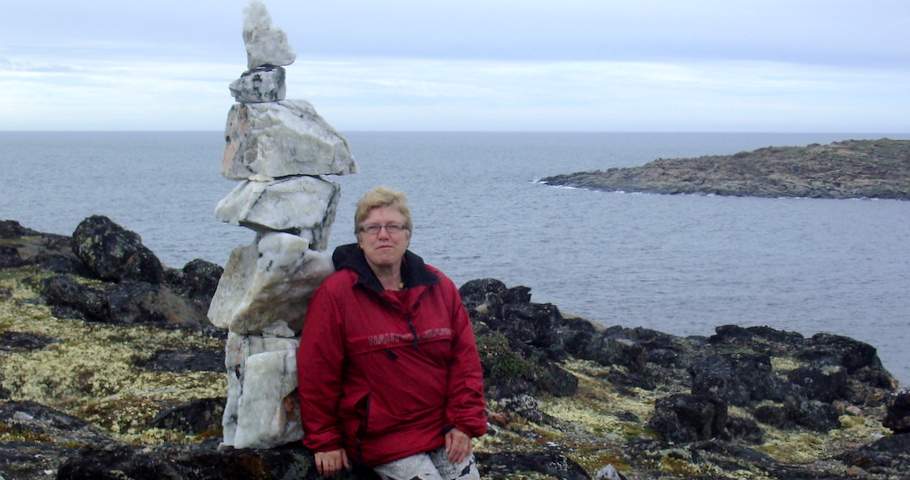 When I decided to start walking from Victoria BC, I was not anticipating my learning curve regarding poverty. As a mother, as an engaged citizen and as a walker with a mission to walk and talk, I was only aware that I needed to bring attention to critical issues facing the children of Nunavik.
When I decided to start walking from Victoria BC, I was not anticipating my learning curve regarding poverty. As a mother, as an engaged citizen and as a walker with a mission to walk and talk, I was only aware that I needed to bring attention to critical issues facing the children of Nunavik.My purpose is to empower women and children on their rights, about
their options and what it takes to actually make a difference.
From my meeting with Mayor Helps, it is an understatement to say that housing is a Canadian concern.
Although she did state that BC was in a good position to build social housing conditional upon the other half of the money coming from another source (CRD), my heart was skipping a beat thinking about the people of the North. In the case of BC, there is to be an announcement soon.
From walking in Victoria 3 days, it was obvious why it was recommended that I have my walking sticks. To date, I have met so many homeless people, I also now understand why when one goes into a Tim Horton, a MacDonald or a Subway, one has to ask to have the washroom door unlocked mechanically. At Subway, a worker explained why they put in a special lamp which makes your hands and face look bluish, but helps the addicted find their veins.
Into my third day, I met my first two Inuit residents looking for cigarette butts. When I spoke to Mayor Helps, I said how cities are now offering transition courses for the Inuit who move south. One reason is that they get better services even though poverty makes many of them into homeless vagrants when they first arrive.
As I tried to identify landmarks in Victoria, I lost count of the number of homeless women wrapped in their sleeping bags or youths in pajamas with a yoga mat strapped to their back or on a head band. Tent city also illustrates what is happening. One cannot, not see the problem.
Mayor Helps calls Victoria PARADISE. No doubt it is for the people who can put food on their table, but so many others get disorganized in their attempt to just survive.
In 2007, my interest was sparked by the coming 2008 recession. I was writing a book on THE COST OF BEING POOR which I finally abandoned as a lost cause. People lose their dignity to poverty. It made my heart sink so when I checked it, it was not out of conviction but from the realization that poverty is a community, a city, a provincial and a country problem. Canadians said to live in a rich country, has a problem of poverty.
Did you know that 80% of food bank users are children? That’s the problem. Compared to other Quebec children, Inuit children are most likely to be born prematurely, to have substandard birth weight, to live in inferior housing or to be born with fetal alcohol disorder syndrome. Compared to other Quebec children, Inuit children are 3 times more inclined to be poor, to live in a female-headed household, to have no employed parents. Finally, compared to other Quebec children, Inuit children are 5 times more likely to be dependent upon welfare. Thus it is not an exaggeration to conclude that in various life-threatening or life-diminishing ways, Inuit children are at greater risk than their Quebec counterparts.
Petition to empower the mothers and to reduce placements of the children
Like all that matters, we have to make the connections with what we can all do to help. This petition to be given to PM Justin Trudeau hopes to restore dignity but also their rights to a stable family and harmonious community. Policies and practices reflect longstanding and deeply embedded mother-blaming culture and father invisibility ideologies that shape child protection systems.No Child Should Take the Long Way Home
Children, mothers, and communities are the object of this project No Child Should Take the Long Way Home. After all, every child is born with the right to have a better chance at a life free from abuse and violence.But the children are very vulnerable when they are removed from their birth families. When they are removed not only from their families but from their community, children lose out on being raised by their own families, in their own communities. As a result, there are increased numbers of Inuit children in child and foster care.
This is an issue for all Canadians. But in some indigenous communities, men are rarely, if ever, assessed for failure to protect. Even when a child has two parents, “neglect” investigations focus primarily on the mothers. Child protection workers routinely engage with mothers and ignore fathers and father figures even when fathers are the identified source of a family’s difficulties. I saw this in action in Nunavik. When I worked among them, I was confronted with a structure that had too much red tape bringing with it many walls for the Inuit women; so much oversight that women did not get the benefits of justice; too many high end players with their own agendas and too well written scripts emphasising the importance of child protection to the exclusion of understanding the family context.
No Child Should Take the Long Way Home is a grassroot initiative to help children in need of loving care, of a protective and stable environment to meet their basic needs for protection, shelter, and education in a safe house in their own community.







No comments:
Post a Comment